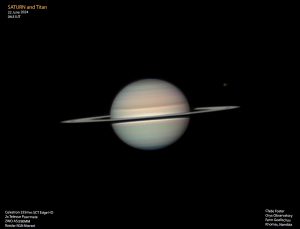
Activity areas: Sun, Moon, Planets, Satellites, Comets, Meteors, Asteroids, Occultations.
Observing Guides: satellites, Sun, Moon, planets, comets, meteors, asteroids, occultations.
Specialists & Collaborators: Tim Cooper, Greg Roberts
Section newsletter: Southern Skies archives
Contact us: [ shallowsky
ASSA Planetary Section
Section Director: Clyde Foster
The Planets
For many, the first glimpse of one of the planets, even through a relatively small telescope, will forever remain a special memory. Whether it be the rings of Saturn, the dynamic moons and belts of Jupiter or the tiny reddish disk of Mars, each planet holds its own beauty and fascination.
The range of interests and observation open to the amateur astronomer in the planetary field is vast. Many will be satisfied with informally seeking out each of the planets in the night sky or following one or more of their favourite planets more closely over time. This in itself can give the observer tremendous enjoyment. Further satisfaction can be derived by personal reading and online research which gives insight into the wonders of the planets being observed. Our knowledge of our closest neighbours in space has grown immensely with the growing number of spacecraft missions, including orbiters and rovers on Mars, which is very likely to be visited by humans in the next 10 years or so.
For those wishing to take their planetary interest further, there are a wide range of projects and studies that can be undertaken, with the main requirement being to have the enthusiasm and passion to observe the selected planet/s on a regular basis.
One of the aspects of planetary observing and imaging that the Director of this section has found very exciting over the last 10 years has been the professional-amateur interaction that is taking place in this field, where amateur planetary imagers are able to provide a regular stream of planetary images that are used by professional planetary scientists.
Objectives of the planetary section
This is a newly formed section (as of August 2024), with the following initial objectives:
a) Promote the enjoyment and interest in, observation of, and imaging of, the planets.
b) Highlight (via assavip group, reports, emails, etc) any interesting developments on the planets from an observational perspective.
c) Provide information on any upcoming interesting events related to any of the planets.
d) Continue to represent, and promote, ASSA in the international Pro-Am planetary science community.
A further initial objective is to circulate a regular report highlighting recent observations and interesting planetary developments, whilst communicating any upcoming planetary events of interest. Details will be provided in due course
Email: planetary@assa.saao.ac.za
Alerts
- The Venus’ Cloud Discontinuity in 2022 — 2023 Feb 10
- Update on Clyde’s Spot — 2022 Mar 22
- Star of Bethlehem — 2021 December
- Bolide over the Western Cape — 2021 Aug 09
- Moon, Venus and Mars conjunction photo competition — 2021 August
Previous alerts can be found in the ASSA Website Archive.

